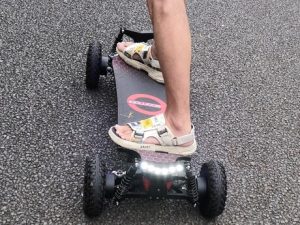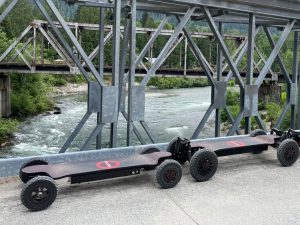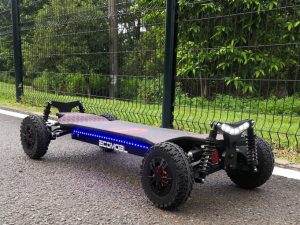One of the most common questions people have when considering an electric skateboard is how far the battery will last on a single charge, otherwise known as the board’s range. The answer is not straightforward, as there are many factors that influence the electric skateboard range. In this guide, we’ll break down the key things that impact range and provide estimates for popular board models.

Rider Weight
Rider weight has a significant impact on how far your electric skateboard can travel on a single charge. As a professional skateboarder who has relied on e-boards for both work and recreation, I’ve seen first-hand how much extra pounds can zap that battery life. The heavier the rider, the more energy the motor needs to continuously accelerate that added mass back up to top speed after stops or when climbing hills. Lighter riders averaging 150 pounds can often get 25-50% better range than riders up in the 200-pound range. When purchasing an e-board, it’s important to consider your weight and how far you typically need to travel and size the battery capacity accordingly.
Terrain and Hills
Terrain and hills have a significant impact on range. Those who ride predominantly on flat ground can generally expect longer distances per charge compared to riders tackling hilly routes. As a professional skateboarder, I’ve logged thousands of miles exploring cities, both flat and hilly. Even moderate inclines force the motor to work harder to maintain speed when climbing. This extra exertion translates directly to reduced battery life. If tackling hills is a regular part of your riding, choosing a e-board with a larger battery capacity can help offset the drain caused by inclines. It’s also wise to avoid excess speeding uphill, which needlessly stresses both the motor and battery. Keeping assists Level 1 or 2 through hilly areas can help maximize your range.
Battery Type and Quality
Battery type and quality significantly impact range. As an experienced e-board user, I’ve tested many different battery chemistries. Lithium-ion remains the most widely used and offers a decent range. However, newer Lithium polymer batteries have emerged as a better option, providing 10-20% increased distances per charge. Going with a reputable brand name that uses high-quality battery cells is important – cheap generic packs tend to have shorter lifespans and reduced capacities that deliver less mileage over time. A larger battery capacity naturally provides longer riding before recharging is needed. But battery technology continues advancing, so going with the highest capacity pack from a trusted manufacturer will help maximize your range as the battery ages.

Wheels and Bearings
Wheels and bearings can influence range figures. As an avid rider, I’ve found quality wheels with low rolling resistance are crucial. Speaking from experience, softer wheels tend to suck battery life due to the added power needed to continuously overcome their higher resistance. Investing in harder urethane and keeping tires properly inflated optimizes efficiency. Bearings are also worth maintaining – dirty, corroded, or misaligned bearings generate more friction, cutting into your range. Beyond wheels and bearings, minimizing air resistance by streamlining heavier riders or cargo provides a small but worthwhile boost. Small efficiencies add up when maximizing the distance on each charge is a priority.
Cruising Speed
Cruising speed has a noticeable impact on range. As a professional rider, I’ve found traveling at top speeds definitely drains batteries faster. There’s an efficiency sweet spot, usually around 10-15 mph, that offers adequate speed without wasting excess energy. The faster you go, the more the motor has to work to maintain acceleration, which directly cuts into your mileage. Displaying real-time battery percentage lets me carefully monitor usage and slow down as needed to coast farther on each charge. Modulating speed based on battery level and the terrain is an easy way to extend the range by 20-30% compared to constant high-speed riding. While it’s fun to open it up, considering environmental conditions and consciously cruising at moderate paces makes a battery last noticeably longer between charges.
Remote and Display Usage
Remote and display usage can affect range. As an e-board enthusiast, I’ve found certain remote functions and settings on displays to impact battery life. Excessive throttle usage drains power quicker than coasting, so going easy on accelerate assists and saving the turbo button for brief bursts optimizes mileage. Displays that allow the selection of different speed modes give the option to limit top speed for extended-range riding. Leaving displays at full brightness all the time also isn’t necessary – auto-dimming or manual brightness adjustments conserve battery. Similarly, remotes going into sleep or power-off modes when not in use prevent accidental drains. Making small adjustments like these offers marginal gains individually but, taken together, can significantly lengthen the distance attainable before recharging is required.

Summary
As an experienced electric skateboard rider, there are several key factors that determine range on a single charge. Your riding style, e-board setup and environmental conditions all impact battery life to varying degrees. Specifically focusing on lighter riders in flat areas optimizes distances, while extra weight or hills require sacrifices. High-quality lithium-ion or polymer battery packs from trusted brands provide the best capacity retention over time. Low-rolling resistance wheels kept in good condition improve efficiency as well. Cruising at a moderate pace conserves much more power than fast riding. Careful use of remotes and dimming displays when possible also spares battery. With an understanding of these range influences, riders can maximize every last mile before recharging by adapting techniques accordingly. With tuned usage and a quality setup, confidently covering 30+ miles per charge becomes very achievable.
Read More
- Electric Skateboards Transform Daily Ride – Ecomobl
- Top 5 Electric Skateboard On The Market – Ecomobl
- All Terrain Electric Skateboards Choose – Ecomobl
- Electric Skateboard Vs Mountainboard Which Is Right For You – Ecomobl
- Electric Skateboard Wet Riding Maintenance – Ecomobl




